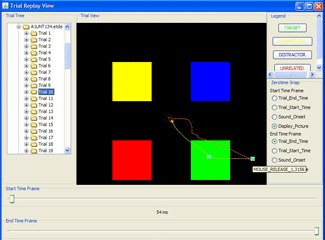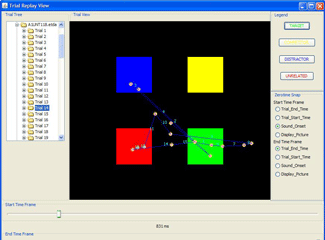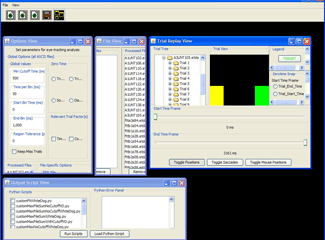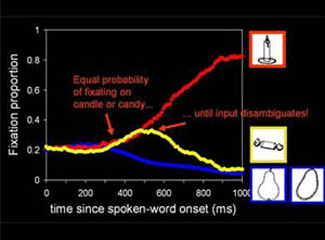Analysis


In order to address these questions, we need a measure that reflects people’s ongoing interpretation of the speech signal. We use people’s eye gaze to a visually present referent of the spoken word.
The eye movements we are interested in are those generated as participants hear the name of the picture they must click on, thus from the onset of the spoken word candle (taken to be time 0). At that point, they may be fixating any picture on the screen (e.g., the picture of the necklace). As the speech signal unfolds and people gain access to the sounds of the picture’s name, they typically initiate an eye movement to a picture with a name that is consistent with the spoken information available so far. For example, the eyes may move to the picture of the candle, landing on it at time 60, moving away from it at time 340, landing on the picture of the candy at time 376, moving away from it at time 598, and finally landing on the target picture candle at time 642.
Thus, the pattern and timing of the eye movements performed as the name of the target picture is heard is taken to reflect on-going interpretation of the spoken word. For instance in the example above, both candy and candle interpretations appear to be simultaneously entertained for a brief period of time.
If we average a large number of trials from many participants, we can generate a plot showing how the proportion of fixations to each of the pictures changes over time. Here, the probabilities of fixating the candy and candle pictures increase simultaneously, while the probabilities of fixating the pear and necklace pictures decrease. Later, presumably when the spoken input begins to disambiguate between the candle and candy interpretations, the probability of fixating the candle picture continues to increase while that of fixating the candy picture begins to decrease.
Armed with this procedure for collecting and analyzing eye-movement data, we can address a large range of questions on spoken-word processing (see Publications for further detail).





